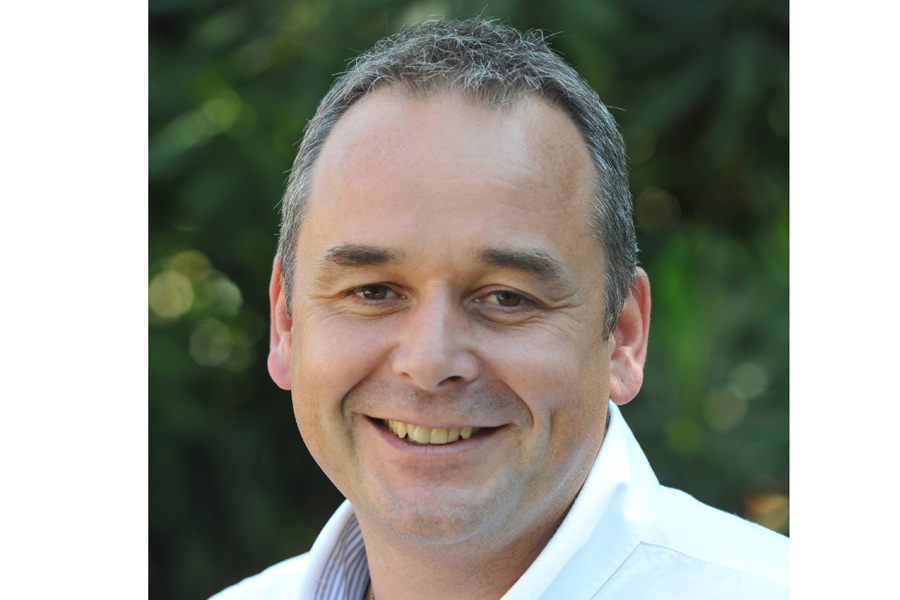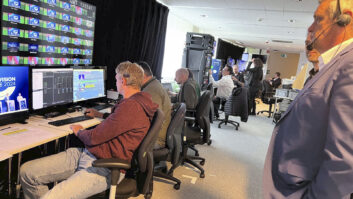
Adam Fry, vice president of Sony Professional Europe, is one of the coolest Joe Cools around. With live sports now providing 90 per cent of top rated shows, his previous executive connections with Pulselive and Hawk-Eye Innovations, along with his instinct for creating fan engagement initiatives, make him the ideal strategist for the transition to a market dominated by OPEX and services on the one hand, and IP, VR, 4K and cyber security technologies on the other.
Fry served as managing director of Pulselive when Sony acquired it in 2011, working closely with World Rugby, the International Cricket Council, The Premier League, Expedia, ESPN and SAP. Punting a ball into the wider market, has Sony re-defined itself already, or is it about to?
“We have had a direction of travel for a number of years. We recognise that the media business is transforming faster than it ever has,” says Fry. “IP is becoming more of a reality, which gives us an impetus to move. On the back of that there will be both fresher hardware coming into the market, and many more software-enabled solutions.
“We have built a strategy to move ourselves into being a services and solutions business, as well as a hardware business. It will be a long time before cameras move into the software domain,” he added. “They are processors. There are different workflows coming into play, both on the solutions side and in services too.”
OPEX is the new obsession
The IABM currently values the market at $49 billion, and while acquisition accounts for nine per cent, some 55 per cent is identified under the services banner, everything from systems integration to rental and transmission. This is surely the growth area.
“That’s right. The reality behind this is the number of dynamic changes caused by the big entrant competition that’s come into the broadcast content business,” says Fry. “With things moving a lot quicker, people do not want to make very large capital investments. They want to buy services on an OPEX model, which allows them to move and adapt as fast as the market does. That gives companies like Sony the opportunity to look at our portfolio and bring new service options to the market.”
These might just be different finance models, or different combinations of hardware and software. It could also imply a switch to cloud-based services whilst maintaining the people with the right skills, as OPEX become the new obsession.
Sony has had a long period of matching its cinematic prowess alongside its broadcast kit, but this time (at IBC) the focus was purely broadcast.
“That’s a fair reflection. Clearly there is a lot of cinematography still out there, and the F65 and F55 are doing very well in that market, but the broadcast market is now very focused on IP and live, and it is moving very quickly in new directions,” says Fry. “The show reflected that, and our stand certainly reflected where the focus of the industry is now. We built a data centre because that is what users are talking about: putting apps in a data centre environment.”
Fry also heard a lot of discussion too about cyber security. “The banking industry moved online quite a few years ago, and there are still breaches there, so this industry has some catching up to do,” he says.
“You need to be able to count on resilience and back-up being built into your solution architecture. The bespoke IT solutions we are building are always resilient. If you get an attack or a crash, they close half the system down and open it up on the second half,” he adds. “This way you can sustain your daily processes. Disaster recovery is what pretty much every customer is asking us for right now: they must recover fast, whether it is a physical disaster or a cyber attack.”
Increasing fan engagement
Looking at Sony thoroughly requires a segment-by-segment approach, so live sports and the 4K buzz make for a good start.
“The consumption of live sports and events is really driving the market. We are bringing out the technology for creating the best content production around live sport, but on top of that we have the Hawk-Eye division,” says Fry. “Hawk-Eye is officiating in many live sports, which is game-changing in its own right because it changes the dynamics of many games, including tennis and cricket.”
Pulselive is something unique to Sony, a company that offers digital management to sports federations. “All this is increasing fan engagement. More content viewers leads to more subscriptions, driving more money back into the industry, and creating a virtuous circle,” says Fry. “That’s when you get something like the HDC-4000, which brings super slo-mo to more and more sports. With the four hours of HFR recording you could leave the camera to record a full football or rugby game.”
The strength of interest in VR already suggests it will not peak and fade like 3D TV did, and many people at IBC had it in their top three technologies to follow.
“That is a really interesting subject. Having been there with 3D and all the other trends, we are now in dialogue with multiple content producers and the biggest broadcasters,” says Fry. “They have their own thoughts about the potential for VR in the broadcast media markets, but there isn’t an answer yet. Lots of people are experimenting with VR and 360-degree productions right now, and we have the Playstation 4 console which has its own VR headset.”
In fact, Sony has shown the big broadcasters a set of developments for VR that it has not spoken publicly about yet. The issues concern what the content will be and who is going to consume it, whilst considering how will it be delivered to audiences, rather than just single headsets. Perhaps young talent will make the first VR blockbusters, with no connection to the broadcasters.
“There is a huge surge of noise around VR, specifically what people expect of it. There may be an ‘out of left field’ approach and that will bring people to thinking about delivery, what apps and what content are going to be the most engaging,” says Fry. “People have very thirsty appetites around VR, and I just look at media and gaming and the spread of entertainment experiences. VR can go way beyond that into areas like active learning. There are many other apps where VR could have an impact on our lives.”
VR as a tool of torture
On a trip to the Sony headquarters in Japan, Fry had a VR content experience that was at first invigorating, but quickly became threatening and quite frightening, so do not rule out VR becoming a tool of torture. What about the non-broadcast markets: corporate, houses of worship, and training?
“That is a very significant portfolio in Sony. We are very lucky that we go from everything for the consumer all the way up to the very highest levels of the professional spectrum. Almost everyone is a content maker now and as we go forward, looking at our other technologies, everyone can become their own broadcaster,” says Fry. “For me that is a very significant part of the market, and we will have to keep pushing the boundaries of content production, and keep pushing the boundaries of camera technology.”
In a market where nearly 40 per cent of vendors are not in profit, and the stress of the transition has hit industry performance, what USP does Sony carry forward?
“We are very strong in the media industry, and we have a very strong backbone around our camera technologies, which will continually evolve. There are more things to come around the development of that technology, but the future is more around the different workflows that emanate around the different types of content production,” says Fry.
Using value ads, Sony expects to lead its customer base through managing assets better in the context of re-purposing and monetising. With workflows suddenly becoming a sexy subject, people will want them controllable day-on-day, depending on job and app.
“People are changing specific workflows in a market that is moving very quickly,” says Fry. “The creatives and the technologists should be working hand-in-hand and really understanding what it is they are generating, what they are trying to create.”
It is only a case of when
Sony has its solution architects and tech teams, and these have spent a lot of hours looking at what the user is really looking to achieve either creatively or operationally. Fry does not believe we have a talent shortage.
“We get it. We get exactly the sound you are looking to create. We understand the video image you have in your mind, and we can deliver that. That’s a very real thing,” he says.
“I see a lot of young people who are very open-minded, who pick up both the technical side and the creative side very quickly. You only have to look at Pulselive, where the average age of staff is 24 and the MD is 28. They work with the Premier Leagues of this world, which are very conscious about the value of their assets, and they build a complete platform,” he added. “They deliver a great result because they are open minded, and working with the content owner and the image they want to create.”
Fry believes a lot of young talent has already shown itself to be adaptable. He says, “We have got the two worlds of IT and media, which are somewhat traditional in many ways. The hybrid of that or the merger needs a lot of creative talent both technically and design wise. It is out there.”
Sony has got a great deal of value from the IP centre it opened at Pinewood Studios, in terms of identifying what skills and technologies have to prevail.
“We like to think we are at the forefront of educating and being involved in the technology discussion. We already see a lot of PLC organisations where people are testing the IP technology in small environments,” says Fry. “Most have got big projects where it is already earmarked for delivery. It is not a case of if, it is only a case of when. Quite a number of broadcasters are already looking at new IP-based infrastructures.
“There is an interesting dynamic around remote production and low-cost production, which can move the market quicker. There will certainly be more content production on the back of it,” added Fry. “We expect to see a lot more live sport and events, and a lot more content coming from the mid-tier production people, who will see a great opportunity.”
Everyone identifies a key thing for moving IP on from phase one. “Network access is one of the hurdles to get over,” says Fry. “There are a couple of ways it can become better and one is obviously 5G. You may be able to get a decent amount of bandwidth or reserve an element of bandwidth. In Locarno we showed that a full production in the cloud is absolutely viable. There may be some changes you would make around your production techniques, but low-cost production is possible in the cloud today.”
Off sped the man whose sports initiatives include real-time voting on Match of The Day. “The market will move because it will say by using IP we can do a lot more production than we would ever have been able to afford to do before.”







